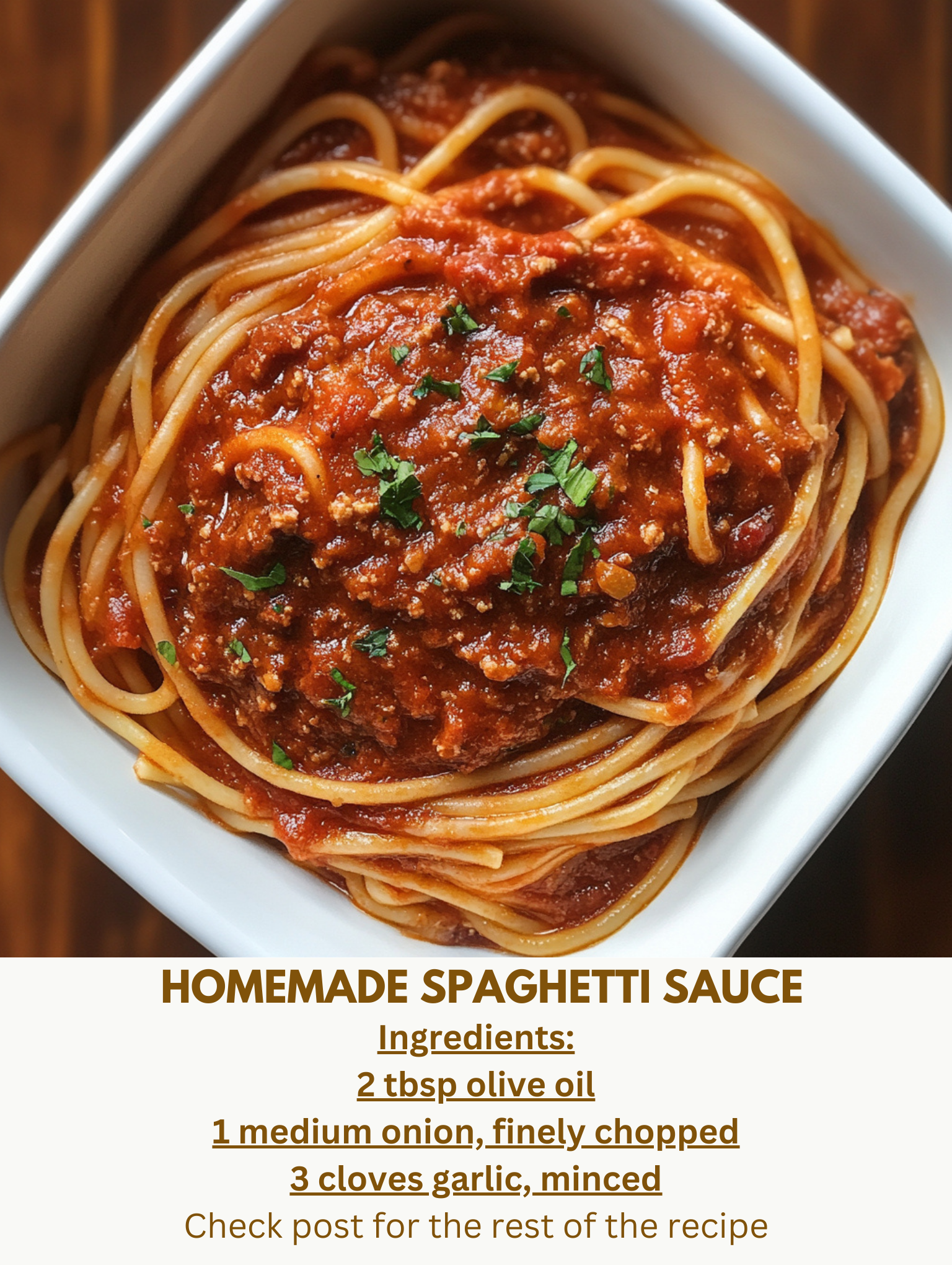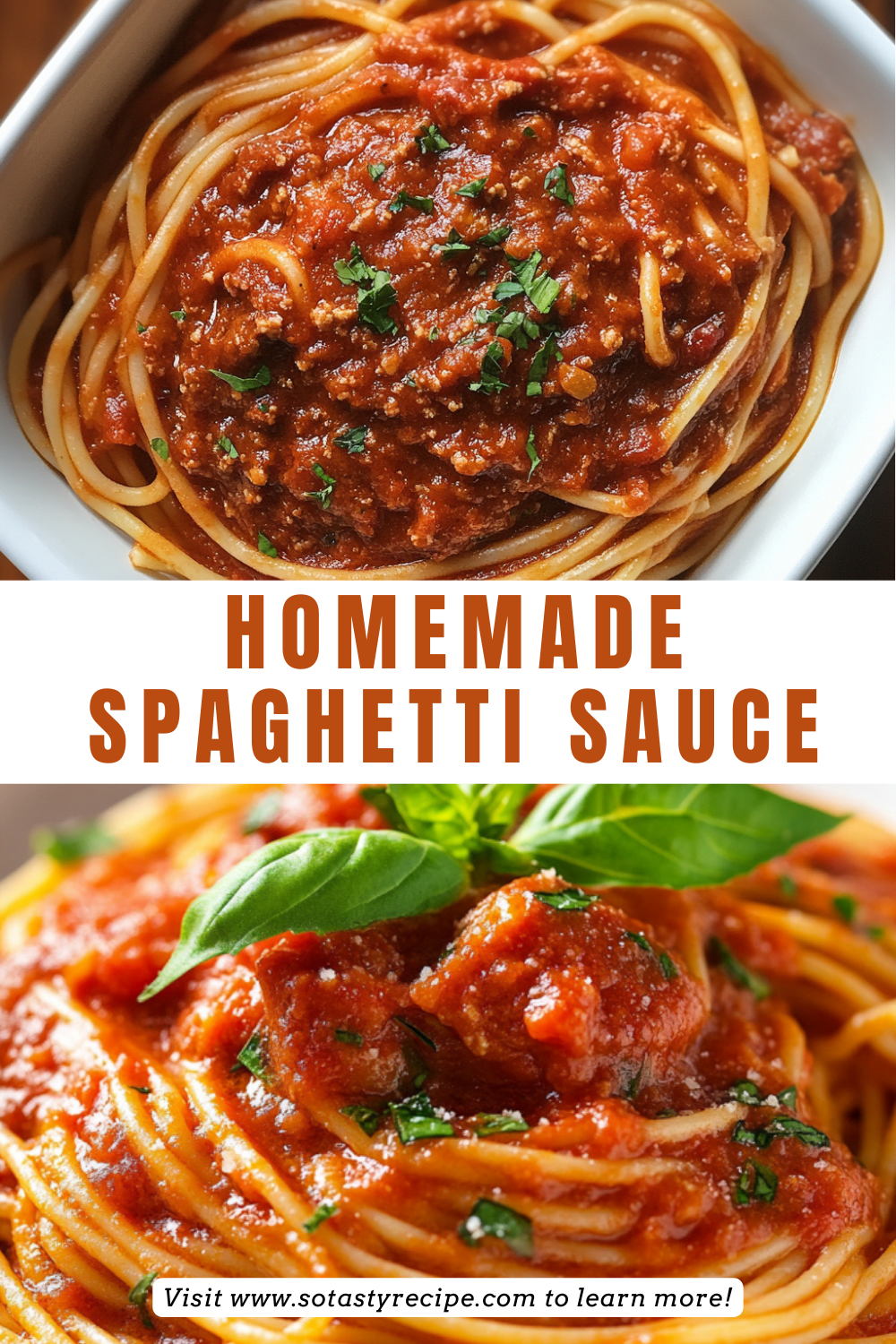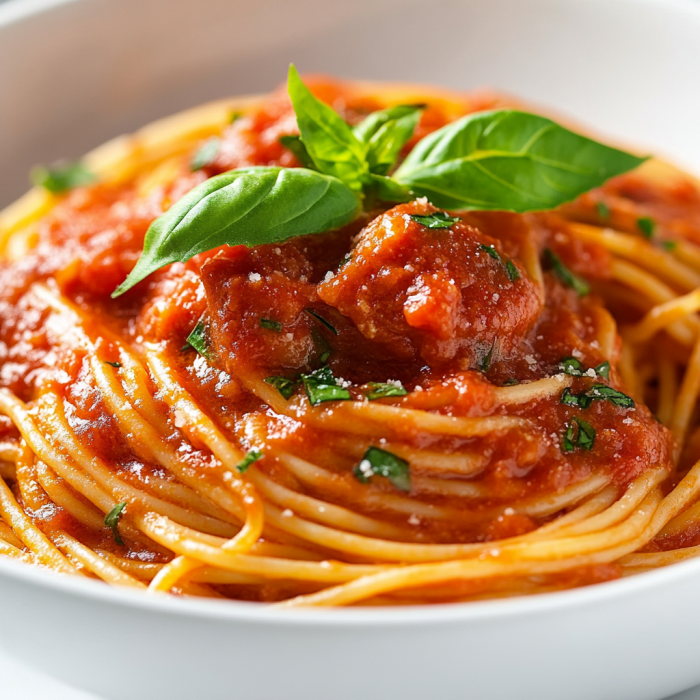Looking for a flavorful, easy-to-make homemade spaghetti sauce? This recipe offers a rich, savory base for your pasta dishes.
Making homemade spaghetti sauce from scratch brings a unique depth of flavor and authenticity to any pasta dish. Whether you’re looking to create a comforting family meal or impress your guests with a homemade touch, this recipe will provide a rich, savory base for your favorite pasta.
This article will walk you through all the steps necessary to prepare your own homemade spaghetti sauce, including ingredient suggestions, preparation tips, and alternative variations to suit every taste. Plus, we’ll explore some key pairing options and answer some frequently asked questions to ensure you’re confident in creating this delightful sauce.
The Magic Behind Homemade Spaghetti Sauce
Homemade spaghetti sauce is the perfect way to enhance your pasta meals with a bold, fresh flavor that store-bought sauces just can’t replicate. What makes homemade spaghetti sauce special is its ability to bring together a variety of ingredients that create a perfect balance of sweetness, acidity, and savory richness. The fresh ingredients, such as tomatoes, onions, and garlic, meld beautifully to give you an unforgettable sauce with a touch of Italian charm.
In the upcoming section, we will go over the essential ingredients for making this homemade spaghetti sauce. Then, we’ll detail the preparation process, cooking time, and storage tips.
To learn more about the science behind making spaghetti sauce, feel free to check out this helpful guide on tomato sauces.
The Key Ingredients for Homemade Spaghetti Sauce
To get the best homemade spaghetti sauce, you must start with the freshest ingredients. Here are the essential components:
-
Tomatoes: The base of any good spaghetti sauce is ripe, juicy tomatoes. You can either use fresh tomatoes or opt for canned tomatoes, particularly crushed or whole peeled tomatoes, which provide a great texture.
-
Olive Oil: This oil is a must for sautéing the onions and garlic. It helps to bring out the rich flavors and makes the sauce smooth.
-
Garlic and Onion: These aromatic ingredients are the foundation of the sauce, adding depth and fragrance. Their sweetness is balanced by the acidity of the tomatoes.
-
Herbs: Fresh or dried basil, oregano, and thyme are classic choices that elevate the flavor of your sauce. A pinch of crushed red pepper flakes adds a touch of heat, though this is optional.
-
Salt and Pepper: Season to taste with salt and black pepper. The balance of seasoning is key to making the sauce flavorful.
In the subsequent chapter, we will discuss how to prepare these ingredients and cook them to perfection.
How to Make Homemade Spaghetti Sauce
Here is a step-by-step guide to making your homemade spaghetti sauce.
Ingredients:
-
2 tbsp olive oil
-
1 medium onion, finely chopped
-
3 cloves garlic, minced
-
2 cans (28 oz each) crushed tomatoes (or fresh tomatoes)
-
2 tsp dried basil
-
1 tsp dried oregano
-
1/4 tsp crushed red pepper flakes (optional)
-
Salt and black pepper to taste

Instructions:
-
Sauté the aromatics: Heat olive oil in a large pot over medium heat. Add the chopped onion and cook until soft, about 5-7 minutes. Add the minced garlic and cook for another minute until fragrant.
-
Add the tomatoes: Pour in the crushed tomatoes and stir to combine. If using fresh tomatoes, blend them into a smooth puree before adding them to the pot.
-
Season the sauce: Stir in basil, oregano, and red pepper flakes (if using). Add salt and pepper to taste.
-
Simmer the sauce: Lower the heat and let the sauce simmer for about 30 minutes, stirring occasionally. The longer it simmers, the more flavorful it will become. If you prefer a thicker sauce, let it cook a bit longer. For a more runny sauce, add a little water or broth.
-
Final touches: Taste the sauce before serving. Adjust the seasoning as necessary. If the sauce is too acidic, a pinch of sugar can balance it out.
This homemade spaghetti sauce will be rich, flavorful, and ready to coat your favorite pasta. For an additional layer of flavor, consider adding a tablespoon of fresh, chopped basil or a dash of grated Parmesan cheese.
In the next part, we’ll discuss variations and substitutions that allow you to make this sauce your own.
Variations and Substitutions
Homemade spaghetti sauce is a versatile dish, so feel free to make changes based on your preferences or available ingredients.
Ingredient Substitutions:
-
Tomatoes: If you prefer a smoother sauce, you can use tomato paste or puree. Alternatively, for a chunkier sauce, leave the tomatoes in larger pieces.
-
Herbs: If you don’t have fresh basil or oregano, substitute with Italian seasoning or any herbs you have on hand, such as parsley or marjoram.
-
Add meat: If you want to make a meat sauce, ground beef, turkey, or lamb can be added. Brown the meat along with the onions and garlic.
-
For a sweeter sauce: You can add a little honey or a grated carrot to cut the acidity of the tomatoes.
Regional Variations:
-
Neapolitan Sauce: This version often includes anchovies and capers for an extra umami flavor.
-
Sicilian Sauce: Known for its addition of olives, capers, and sometimes raisins, this gives the sauce a unique sweet and salty balance.
-
Spicy Arrabbiata Sauce: Add more red pepper flakes for a spicier version of the classic spaghetti sauce.
Moving forward, we’ll take a look at pairing options and accompaniments that will elevate your meal.
Pairings and Accompaniments
A good homemade spaghetti sauce can be paired with various sides, beverages, and complementary dishes.
-
Sides: Garlic bread, a side salad with balsamic vinaigrette, or roasted vegetables make excellent companions to spaghetti.
-
Beverages: If you prefer non-alcoholic beverages, consider pairing your spaghetti with sparkling water or iced tea. For a more traditional Italian meal, you could pair it with a non-alcoholic wine or an iced herbal tea.
-
Complementary dishes: This sauce also works well in baked pasta dishes like lasagna or ziti. You can also use it as a dipping sauce for breadsticks or as a base for pizza.
In the subsequent segment, we will discuss how to store your homemade spaghetti sauce for future use.
Storage and Shelf Life of Homemade Spaghetti Sauce
After preparing your homemade spaghetti sauce, you may have leftovers. Here’s how to store and keep it fresh:
-
Refrigeration: Allow the sauce to cool completely before transferring it to an airtight container. Store in the refrigerator for up to 5 days.
-
Freezing: For longer storage, freeze the sauce in freezer-safe containers for up to 3 months. When ready to use, simply thaw it overnight in the refrigerator or reheat directly from frozen.
-
Canning: If you’re looking to preserve the sauce for an extended period, consider canning it. Follow proper canning procedures for safe storage.

In the next part, we will answer some frequently asked questions regarding the homemade spaghetti sauce preparation and troubleshooting.
Frequently Asked Questions (FAQs)
What makes homemade spaghetti sauce watery?
If your homemade spaghetti sauce turns out watery, it could be due to the type of tomatoes used or insufficient simmering. To thicken the sauce, allow it to simmer longer, or add a little tomato paste.
How long is homemade spaghetti sauce good for?
When stored in the refrigerator, homemade spaghetti sauce is typically good for 4-5 days. If frozen, it can last for up to 3 months.
What is the secret to great spaghetti sauce?
The secret to a great homemade spaghetti sauce lies in using fresh, high-quality tomatoes, seasoning it with the right balance of herbs, and allowing it to simmer slowly to develop deep flavors.
Why does homemade spaghetti sauce separate?
If your homemade spaghetti sauce separates, it could be due to an improper emulsification process. Make sure to stir the sauce regularly while cooking and avoid adding too much water or oil.
Best Time to Enjoy Homemade Spaghetti Sauce
Homemade spaghetti sauce is a versatile dish that works perfectly for any meal. It’s great for lunch or dinner, especially when paired with your favorite pasta. You can even enjoy it as a dipping sauce for breadsticks or pizza!
Presentation Tips
For an attractive presentation, serve your spaghetti in a large bowl or plate, top with freshly grated Parmesan, and garnish with a few leaves of basil. Add a drizzle of olive oil for a beautiful finishing touch.
For more interesting tips you can see here www.sotastyrecipe.com
And for recipes lovers, you can check my friend’s blog here www.infloin.com
